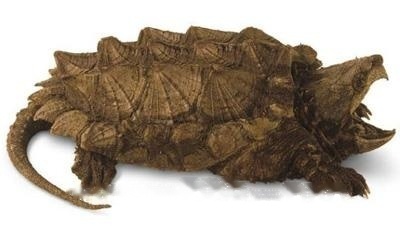
Snapping turtle
Real snapping turtles look like crocodiles fish, Set turtle and crocodile in one, so called true snapping turtle. Its head is relatively thick and cannot be completely retracted in
Character: Lively
Life:80 years
Disease: Rotten skin
Black NeckTurtleis a species unique to China, the black-necked turtle will emit a strange The taste of the turtle, so the locals also call it the smelly turtle. For a long time, this is an unraised turtle species, but in recent years, more and more people like to eat turtles, so the medicinal price of black-neck turtles has been raised. Mesa, causing its price to rise, wild resources began to be scarce.
Chinese name: Black-necked turtle;
Latin name: Chinemysnigricans;
English name: Red-necked pond turtle;
Nicknames: Painted Turtle, Mud Turtle, Three-Line Turtle, Watermelon Turtle, Guangdong Tortoise;
Kingdom: Animalia;
Door: Chordate;
Subphylum: Vertebrate;
Class: Reptile;
Order: Turtle;
Suborder : Turtle;
Family: Turtle;
Subfamily: Turtle;
Genus: Turtle;
Species: Black-necked turtle;
Distribution area: Guangdong, Hainan, Guangxi, China;
Usually body length: 20cm;
Food attributes: Black-necked turtles tend to be omnivorous, and their food includes insects, Snails, small fish, aquatic plants, etc. The food of black-necked turtles mainly includes fish, shrimps, earthworms, tenebrio molitors, snails, mussels, animal offal, etc ; ) living in low temperature (temperature below 15 ℃) environment. The optimum temperature is 25℃, and hibernates when the ambient temperature is around 18℃;
Reproduction: The black-necked turtle lays 2 eggs each time, with a long diameter of 51 mm and a short diameter of 27 mm. Egg weight unknown.
Black-neckedTurtle's biggest feature is black, which is not only a black-necked turtle, but an adult black-necked tortoise is black all over its body. Sexually mature male tortoises are similar, except that black-necked tortoises are black regardless of male or female.
Black-necked tortoises are larger, with carapaces usually 12-25cm long and 11-19cm wide. The carapace is oblong and flat, with a distinct longitudinal ridge without lateral ribs. The carapace of adult tortoises is generally tan or dark brown (the carapace of young tortoises is slightly dark brown), and the central part of each scutellum is lighter in some individuals. The adult plastron is black, and the juvenile plastron is brownish-yellow, with irregular tan markings on the edges of each scutellum. The bridge of the nail is brown, black-brown or brown-gray, which is obviously different from the color of the plastron.
The head is large and broad, and the snout is blunt, slightly protruding from the upper beak and beveled inward and inferior. The intersection angle of the lower jaw and the left and right dentine symphysis is greater than or equal to 90 degrees. The head is black, with yellow-green stripes on the side (the side of the larvae's head or neck is orange-red). Limbs black without stripes, with webbed fingers and toes. The tail is black and short. Female turtles are larger in size, with shorter tails and cloacal openings closer to the rear edge of the carapace. Male tortoises are smaller in size, with a thick and longer tail base, and the cloaca hole is far from the rear edge of the carapace.
Black-neckedTurtles tend to be omnivorous, food including insects, snails, small fish, aquatic plants, etc. The black-necked turtle's food mainly includes fish, shrimp, earthworms, mealworms, snails, mussels, and animal offal.
The black-necked turtle lays 2 eggs each time. The egg length is 51 mm and the short diameter is 27 mm. The egg weight is unknown. The feeding amount of black-necked crow is 5% of the turtle's body weight, and it can be increased to 8% to 10% before the breeding period. Generally, it is fed once every 3 days. In autumn, the feeding amount can be increased to prepare the turtle's body for hibernation. Nutrient reserves.
The black-necked tortoise loves warmth and is afraid of cold, and cannot live in a low temperature (less than 15°C) environment for a long time (more than 3 months). hibernate. Under artificial feeding, mainly lean pork, shrimp, poultry offal and a small amount of vegetable leaves are fed. When feeding, it is suitable to use thick containers such as larger aquariums and cement pools.
black-neckedTurtleLike other aquatic turtles, the environmental requirements of the juvenile tortoise and the adult tortoise period are different, but the water quality is also required to be clean, and the black neck is below. A brief introduction to the environment layout of the turtle.
1. Indoor environment layout of black-necked turtles
In the artificial environment, black-necked turtles are generally treated as water turtles, and the small turtles can adapt to the life of the aquarium well. Shallow aquariums or plastic t-shirt boxes are the most useful feeding places for turtle hatchlings. Due to poor swimming skills, it is recommended that the water depth be no more than 2 inches (about 5 cm) and that a dry plateau for basking be built at one end of the habitat. This allows them to stand underwater and breathe without difficulty. Since shallow water is difficult to filter and leftover food quickly contaminates the water, this arrangement requires frequent water changes.
Black-necked tortoises in the natural environment usually bask on logs and stones. In artificial environments, a basking spot can be set up with reflector lamps purchased from hardware stores. The lamp should be placed at an appropriate height to ensure that the temperature of the lighted area is maintained at about 32 degrees Celsius, and a full-spectrum fluorescent lamp should be configured to provide the UVB light necessary for the synthesis of vitamin D3 (an essential substance for calcium metabolism).
2. Outdoor rearing environment for black-necked turtles
Once the turtle's carapace length exceeds 7.5cm, rearing in a protected outdoor habitat can provide There are many benefits that indoor breeding does not have. Since black-necked tortoises do not hibernate completely, areas where outdoor temperatures can approach freezing in winter must provide them with habitats that do not freeze over.